Panasonic of North America 96NKX-TG2431 2.4 GHz FHSS Cordless Telephone System User Manual TG2431
Panasonic Corporation of North America 2.4 GHz FHSS Cordless Telephone System TG2431
User Manual
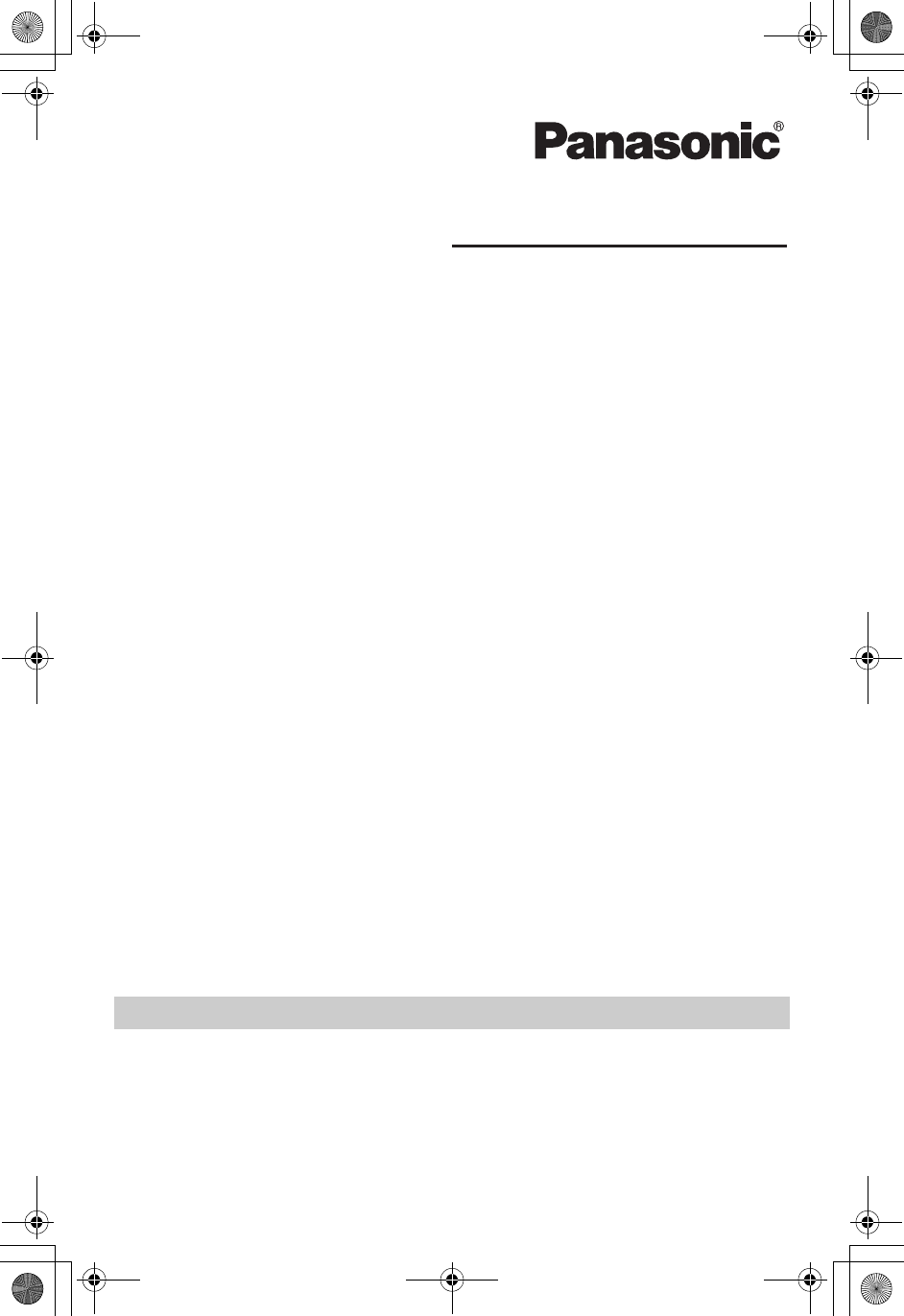
This unit is compatible with Caller ID. To use this feature, you must
subscribe to the appropriate service of your service provider.
Please read these Operating Instructions before using the unit and save
for future reference.
For assistance, visit our website: http://www.panasonic.com for
customers in the U.S.A. or Puerto Rico.
Charge the battery for 6 hours before initial use.
2.4 GHz Digital Cordless Answering System
Model No. KX-TG2431
Operating Instructions
TG2431.book Page 1 Wednesday, September 22, 2004 1:17 PM
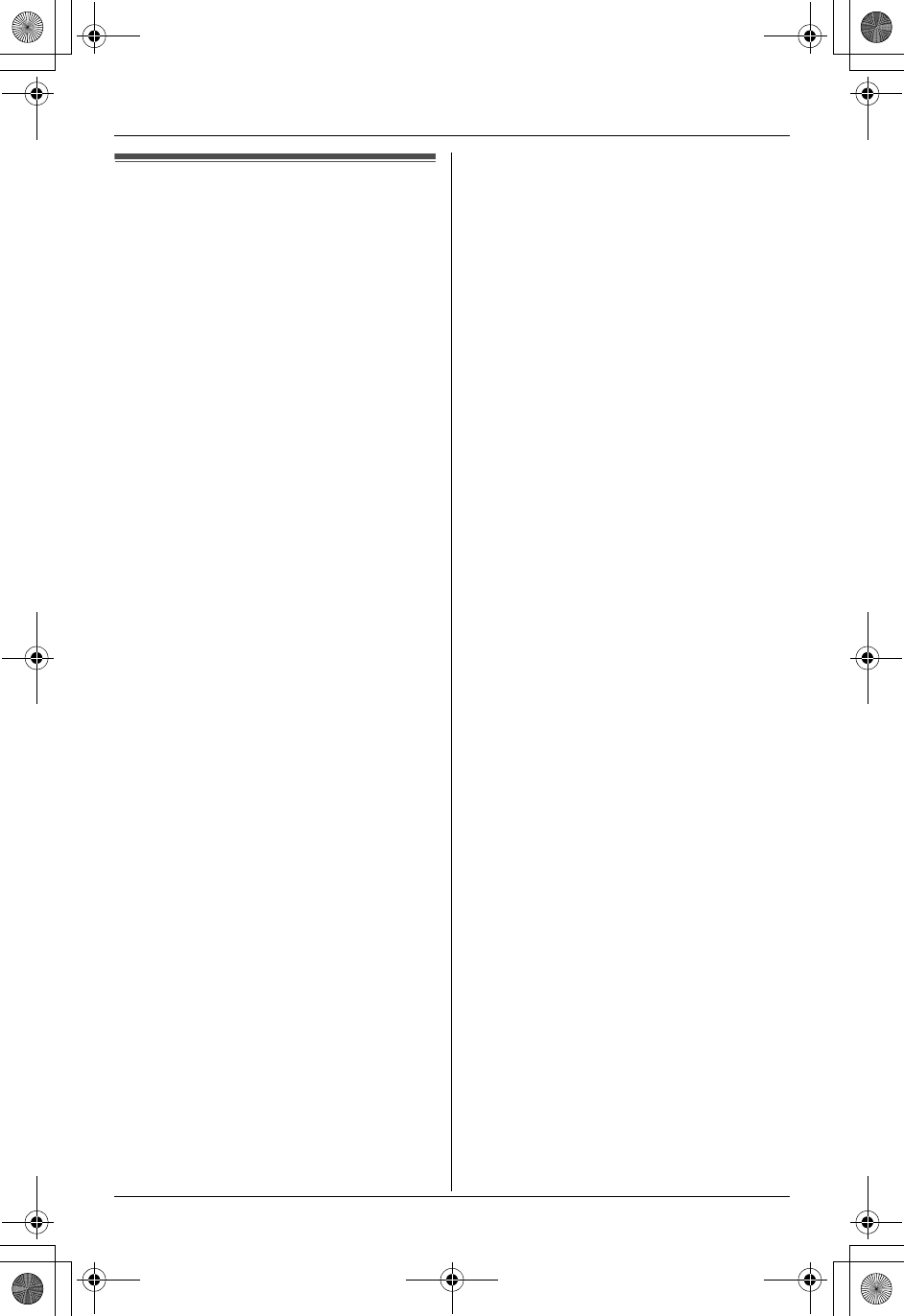
2
Important safety
instructions
When using this unit, basic safety
precautions should always be followed to
reduce the risk of fire, electric shock, or
personal injury.
1. Read and understand all instructions.
2. Follow all warnings and instructions
marked on this unit.
3. Unplug this unit from power outlets
before cleaning. Do not use liquid or
aerosol cleaners. Use a damp cloth for
cleaning.
4. Do not use this unit near water, for
example near a bathtub, wash bowl,
kitchen sink, etc.
5. Place the unit securely on a stable
surface. Serious damage and/or injury
may result if the unit falls.
6. Do not cover slots and openings on the
unit. They are provided for ventilation
and protection against overheating.
Never place the unit near radiators, or
in a place where proper ventilation is
not provided.
7. Use only the power source marked on
the unit. If you are not sure of the type
of power supplied to your home,
consult your dealer or local power
company.
8. Do not place objects on the power
cord. Install the unit where no one can
step or trip on the cord.
9. Do not overload power outlets and
extension cords. This can result in the
risk of fire or electric shock.
10. Never push any objects through slots
in this unit. This may result in the risk of
fire or electric shock. Never spill any
liquid on the unit.
11. To reduce the risk of electric shock, do
not disassemble this unit. Take the unit
to an authorized service center when
service is required. Opening or
removing covers may expose you to
dangerous voltages or other risks.
Incorrect reassembly can cause
electric shock when the unit is
subsequently used.
12. Unplug this unit from power outlets and
refer servicing to an authorized service
center when the following conditions
occur:
A. When the power cord is damaged
or frayed.
B. If liquid has been spilled into the
unit.
C. If the unit has been exposed to rain
or water.
D. If the unit does not work normally
by following the operating
instructions. Adjust only controls
covered by the operating
instructions. Improper adjustment
may require extensive work by an
authorized service center.
E. If the unit has been dropped or
physically damaged.
F. If the unit exhibits a distinct change
in performance.
13. During thunderstorms, avoid using
telephones except cordless types.
There may be a remote risk of an
electric shock from lightning.
14. Do not use this unit to report a gas
leak, when in the vicinity of the leak.
SAVE THESE
INSTRUCTIONS
CAUTION:
Installation
LNever install telephone wiring during a
lightning storm.
LNever install telephone jacks in wet
locations unless the jack is specifically
designed for wet locations.
LNever touch uninsulated telephone
wires or terminals unless the telephone
line has been disconnected at the
network interface.
LUse caution when installing or modifying
telephone lines.
TG2431.book Page 2 Wednesday, September 22, 2004 1:17 PM
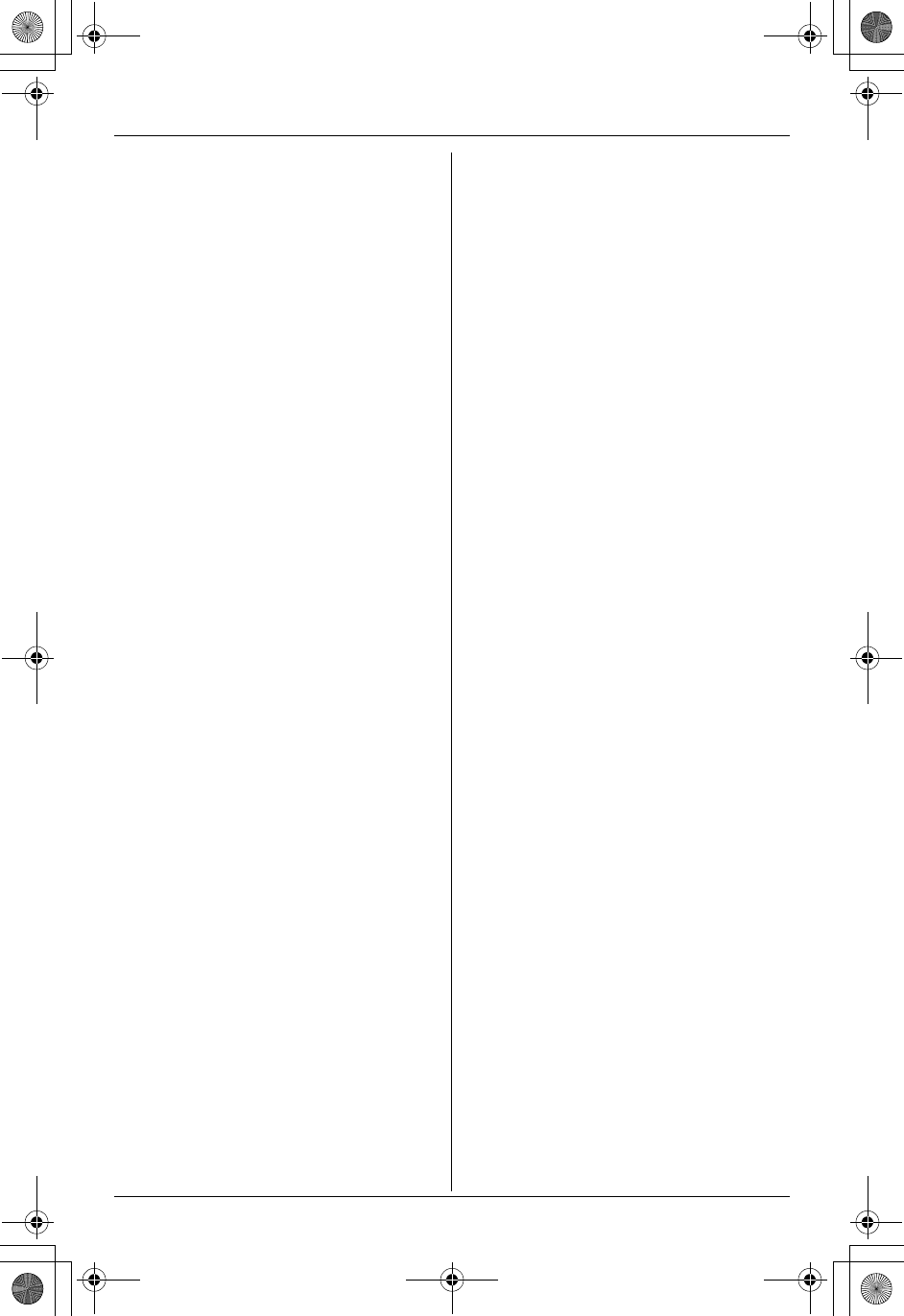
3
LDo not touch the plug with wet hands.
Medical
LConsult the manufacturer of any
personal medical devices, such as
pacemakers or hearing aids, to
determine if they are adequately
shielded from external RF (radio
frequency) energy. (The unit operates in
the frequency range of 2400 MHz to
2481 MHz, and the power output level
can range from 0.04 to 0.1 watts.) Do not
use the unit in health care facilities if any
regulations posted in the area instruct
you not to do so. Hospitals or health care
facilities may be using equipment that
could be sensitive to external RF (radio
frequency) energy.
Battery
To reduce the risk of fire or injury to
persons, read and follow these
instructions.
LUse only the battery(ies) specified.
LDo not dispose of the battery(ies) in a
fire. They may explode. Check with local
waste management codes for special
disposal instructions.
LDo not open or mutilate the battery(ies).
Released electrolyte is corrosive and
may cause burns or injury to the eyes or
skin. The electrolyte may be toxic if
swallowed.
LExercise care when handling the
battery(ies). Do not allow conductive
materials such as rings, bracelets or
keys to touch the battery(ies), otherwise
a short circuit may cause the battery(ies)
and/or the conductive material to
overheat and cause burns.
LCharge the battery(ies) provided with or
identified for use with this product only in
accordance with the instructions and
limitations specified in this manual.
LDo not immerse in water or leave under
running water.
LKeep the handset away from salt water.
LAvoid exposure to prolonged high
humidity.
LSince water in headset jack may cause
damage, close the headset jack cover
when the optional headset is not in use.
When the optional headset is
connected, do not use the handset with
wet hands.
LIf the handset is wet, wipe with a soft dry
cloth.
LThe base unit is not designed to be
splash resistant. Do not place the wet
handset on the base unit.
WARNING:
LTo prevent the risk of fire or electrical
shock, do not expose this product to rain
or any type of moisture.
LThe AC adaptor is used as the main
disconnect device, ensure that the AC
outlet is located/installed near the unit
and is easily accessible.
TG2431.book Page 3 Wednesday, September 22, 2004 1:17 PM
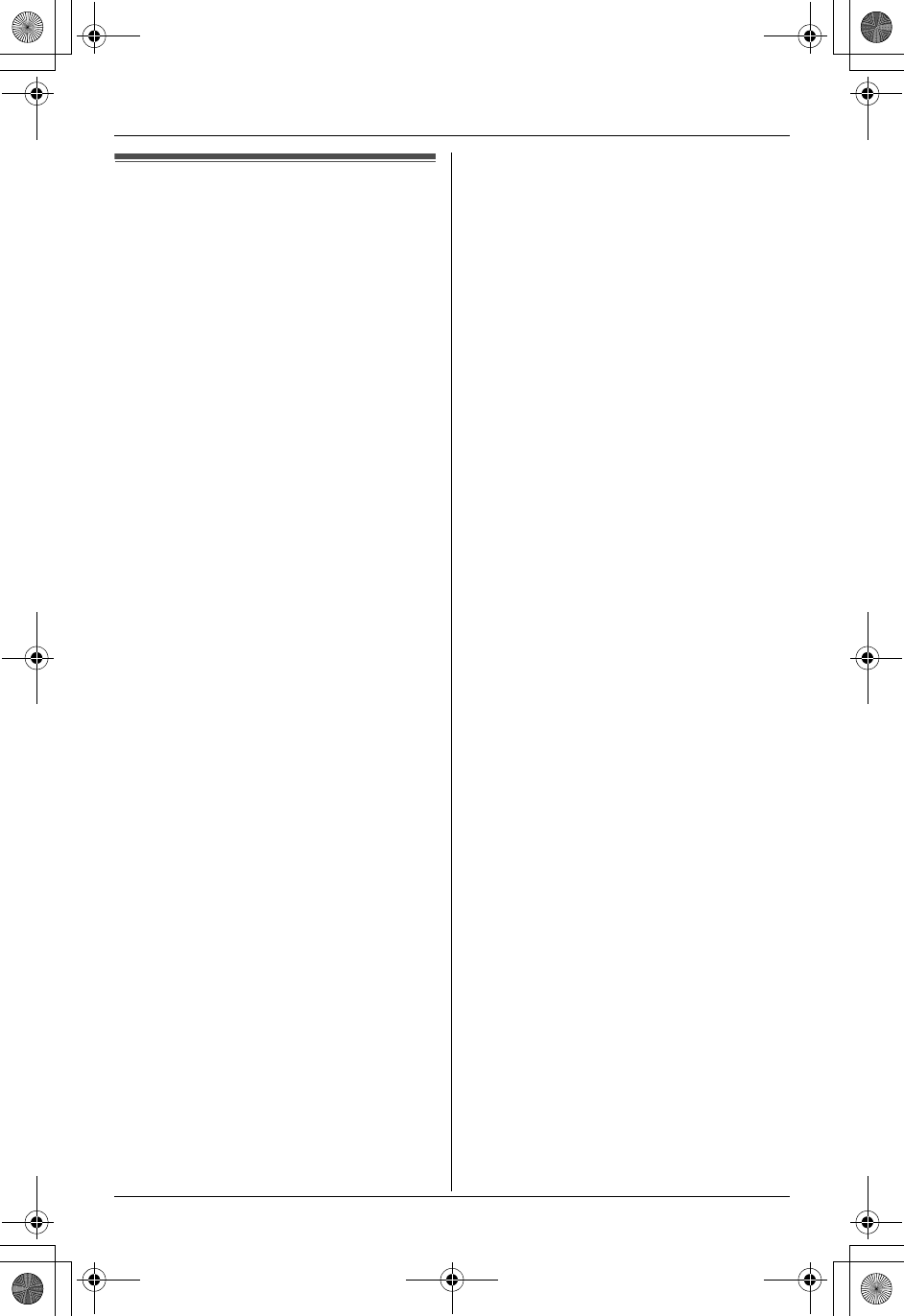
4
For best performance
Base unit location
The base unit and handset use radio
waves to communicate with each other.
For maximum distance and noise-free
operation, we recommend the following:
LPlacing the unit away from electrical
appliances such as a TV, personal
computer or another cordless phone.
LPlacing the base unit in a HIGH and
CENTRAL location with no obstructions
such as walls.
LRaising the antenna vertically.
LIf you use the handset near a microwave
oven which is being used, noise may be
heard. Move away from the microwave
oven and closer to the base unit.
LIf you use the handset near another
cordless phone’s base unit, noise may
be heard. Move away from the other
cordless phone’s base unit and closer to
your base unit.
Environment
LKeep the unit away from electrical noise
generating devices, such as fluorescent
lamps and motors.
LThe unit should be kept free from dust,
high temperature and vibration.
LThe unit should not be exposed to direct
sunlight.
LDo not place heavy objects on top of the
unit.
LWhen you leave the unit unused for a
long period of time, unplug this unit from
power outlet.
LThe unit should be kept away from heat
sources such as heaters, kitchen stoves,
etc. It should not be placed in rooms
where the temperature is less than 5 °C
(41 °F) or greater than 40 °C (104 °F).
Damp basements should also be
avoided.
LOperating near 2.4 GHz electrical
appliances may cause interference.
Move away from the electrical
appliances.
Routine care
LWipe the outer surface of the unit with a
soft cloth. Do not use benzine, thinner or
any abrasive powder.
TG2431.book Page 4 Wednesday, September 22, 2004 1:17 PM
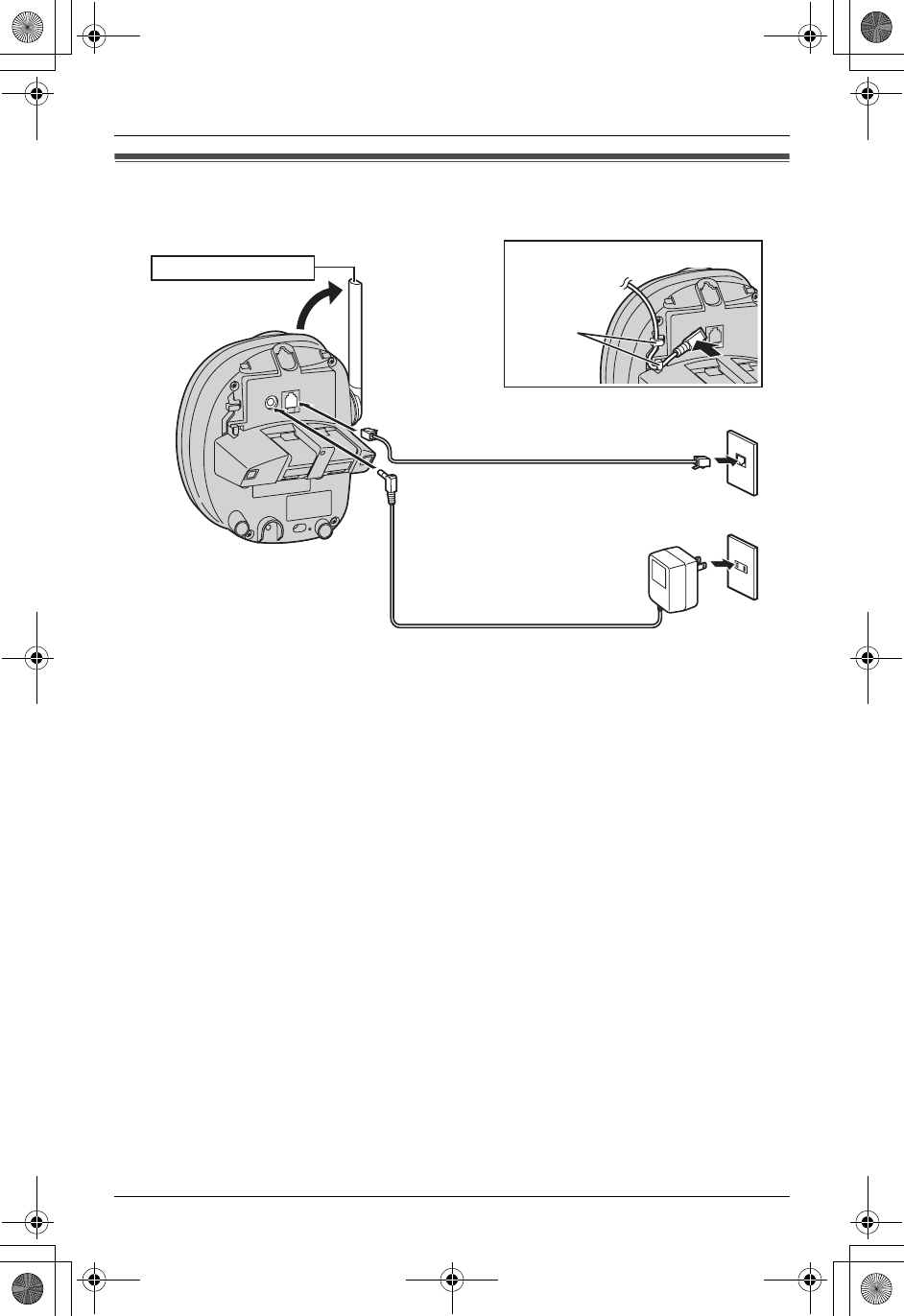
5
Connections
Note:
LUse only the included Panasonic AC adaptor PQLV19.
LThe AC adaptor must remain connected at all times. (It is normal for the adaptor to feel
warm during use.)
LThe AC adaptor should be connected to a vertically oriented or floor-mounted AC outlet.
Do not connect the AC adaptor to a ceiling-mounted AC outlet, as the weight of the
adaptor may cause it to become disconnected.
AC adaptor
Telephone line cord
To single-line telephone jack (RJ11C)
To power outlet (AC 120 V, 60 Hz)
Fasten the AC adaptor cord.
Raise the antenna.
Hooks
TG2431.book Page 5 Wednesday, September 22, 2004 1:17 PM
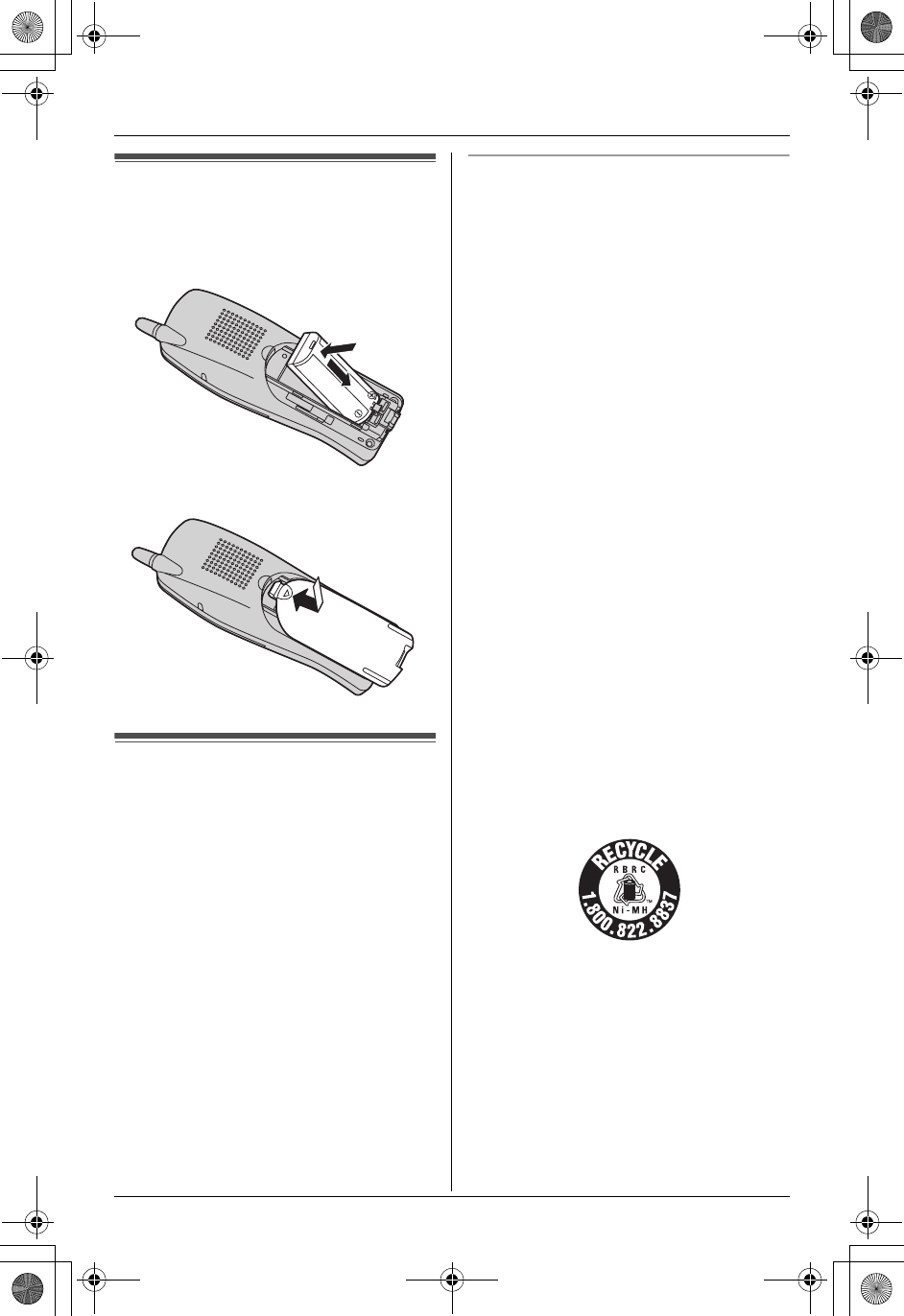
6
Battery installation
1Insert the battery (1), and press it
down until it snaps into the
compartment (2).
2Close the handset cover.
Battery charge
Place the handset on the base unit for 6
hours before initial use.
LThe unit beeps once, the CHARGE
indicator will light, and “Charging” will
be displayed.
L“Charge completed” is displayed
when the battery has been fully charged.
The CHARGE indicator will remain lit.
Note:
LTo ensure the battery charges properly,
clean the charge contacts of the handset
and base unit with a soft, dry cloth once
a month. Clean more often if the unit is
subject to grease, dust or high humidity.
Recharging the battery
Recharge the battery when:
–“Recharge battery” is displayed or
7 flashes on the handset display.
– the handset beeps intermittently while it
is in use.
Note:
LRecharge the handset battery for more
than 15 minutes, or the display will
continue showing the indication.
LIf the battery has been discharged, the
handset will display “Charge for 6h”
and 8 when you place the handset
on the base unit.
LBattery power is consumed whenever
the handset is off the base unit, even
when the handset is not in use. The
longer you leave the handset off the
base unit, the shorter you can actually
talk on the handset. Actual battery
performance depends on a combination
of how often the handset is in use and
how often it is not in use.
LOnce the battery is fully charged, you do
not have to charge it again until
“Recharge battery” is displayed or
7 flashes. This will maximize the
battery life.
Attention:
A nickel metal hydride battery that is
recyclable powers the product you have
purchased.
Please call 1-800-8-BATTERY for
information on how to recycle this battery.
1
2
TG2431.book Page 6 Wednesday, September 22, 2004 1:17 PM
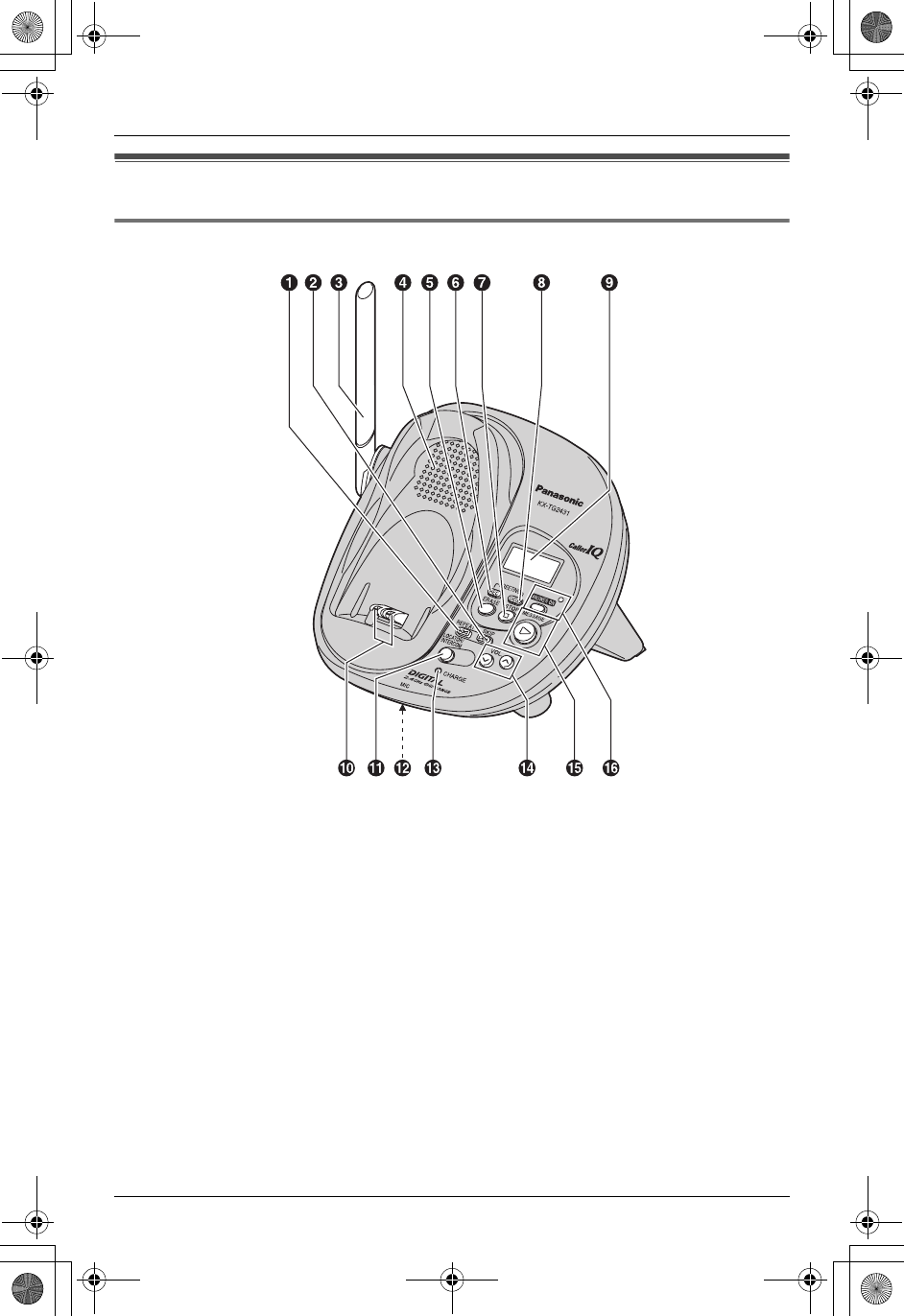
7
Controls
Base unit
A{H} (Repeat)
B{G} (Skip)
CAntenna
DSpeaker
E{ERASE}
F{GREETING REC} (Recording)
G{STOP}
H{GREETING CHECK}
IDisplay
JCharge contacts
K{LOCATOR/INTERCOM}
LMIC (Microphone)
MCHARGE indicator
NVOL. (Volume) {<} {>}
O{MESSAGE}
MESSAGE indicator
P{ANSWER ON}
ANSWER ON indicator
TG2431.book Page 7 Wednesday, September 22, 2004 1:17 PM
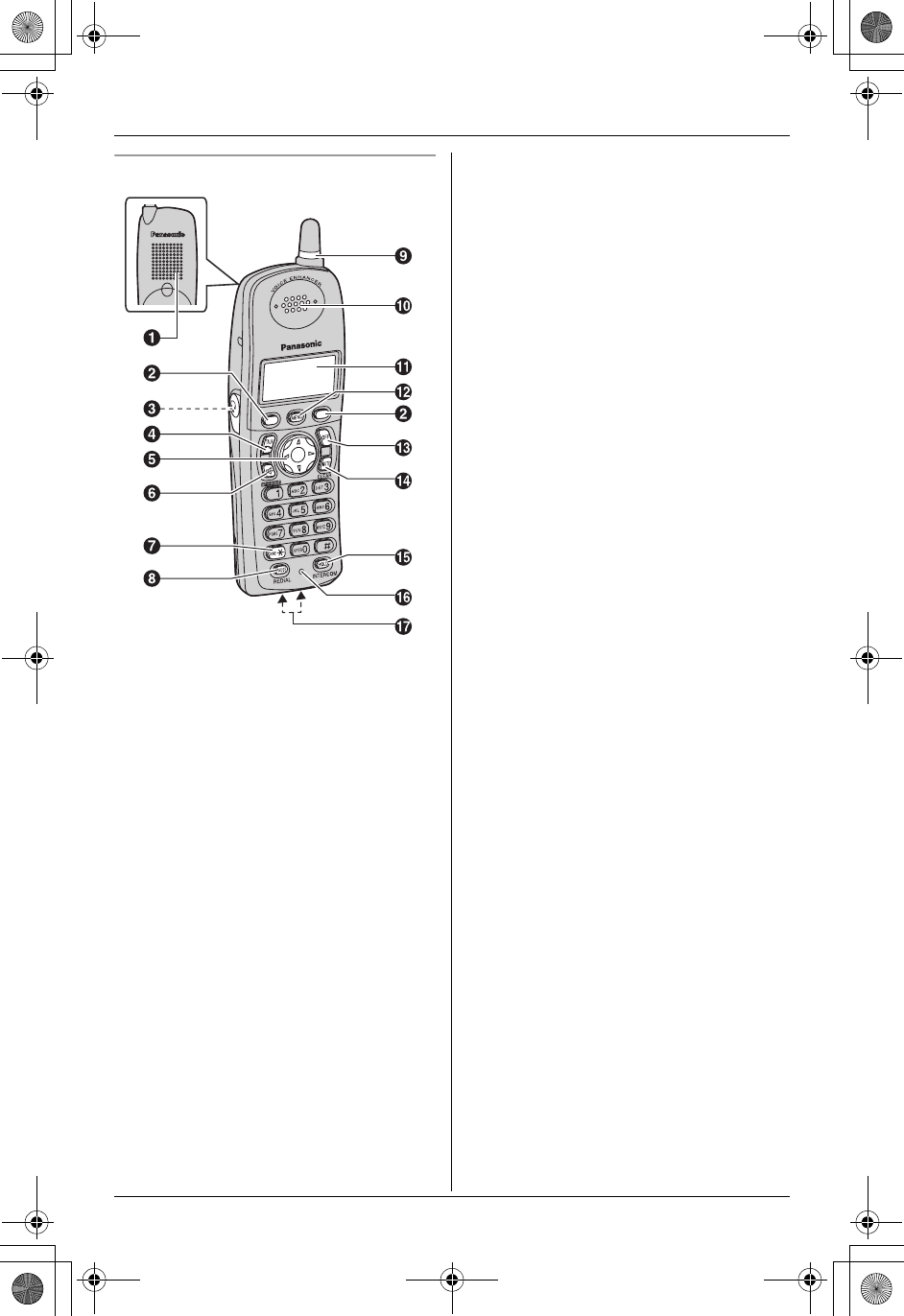
8
Handset
ASpeaker
BSoft key
CHeadset jack
D{C} (TALK)
ENavigator key
F{s} (SP-PHONE)
G{*} (TONE)
H{PAUSE}{REDIAL}
IRinger indicator
Message indicator
JReceiver
KDisplay
L{MENU}
M{OFF}
N{MUTE} {CLEAR}
O{HOLD} {INTERCOM}
PMicrophone
QCharge contacts
TG2431.book Page 8 Wednesday, September 22, 2004 1:17 PM

9
Making calls
1Lift the handset and press {C}.
L“Talk” will be displayed.
2Dial the phone number.
3When finished talking, press {OFF} or
place the handset on the base unit.
Note:
L“Line in use” is displayed when
someone is talking on another phone.
To adjust the receiver volume
3 levels (high/medium/low) are available.
While using the receiver, press {V} or {^}
repeatedly.
To use the speakerphone
1Lift the handset and press {s}.
L“SP-phone” will be displayed.
2Dial the phone number.
3When the other party answers, talk into
the microphone.
4When finished talking, press {OFF} or
place the handset on the base unit.
Note:
LTalk alternately with the caller in a quiet
room.
LIf the other party has difficulty hearing
you, press {V} to decrease the speaker
volume.
LWhile on a call, you can switch from the
receiver to the speakerphone by
pressing {s}. To switch back to the
receiver, press {C}.
To adjust the speaker volume
6 levels (high to low) are available.
While using the speaker, press {V} or {^}
repeatedly.
To redial the last number dialed
1Press {C} or {s}.
2Press {REDIAL}.
Answering calls
When a call is being received, the ringer
indicator flashes rapidly.
1Lift the handset and press {C} or {s}.
2When finished talking, press {OFF} or
place the handset on the base unit.
TG2431.book Page 9 Wednesday, September 22, 2004 1:17 PM
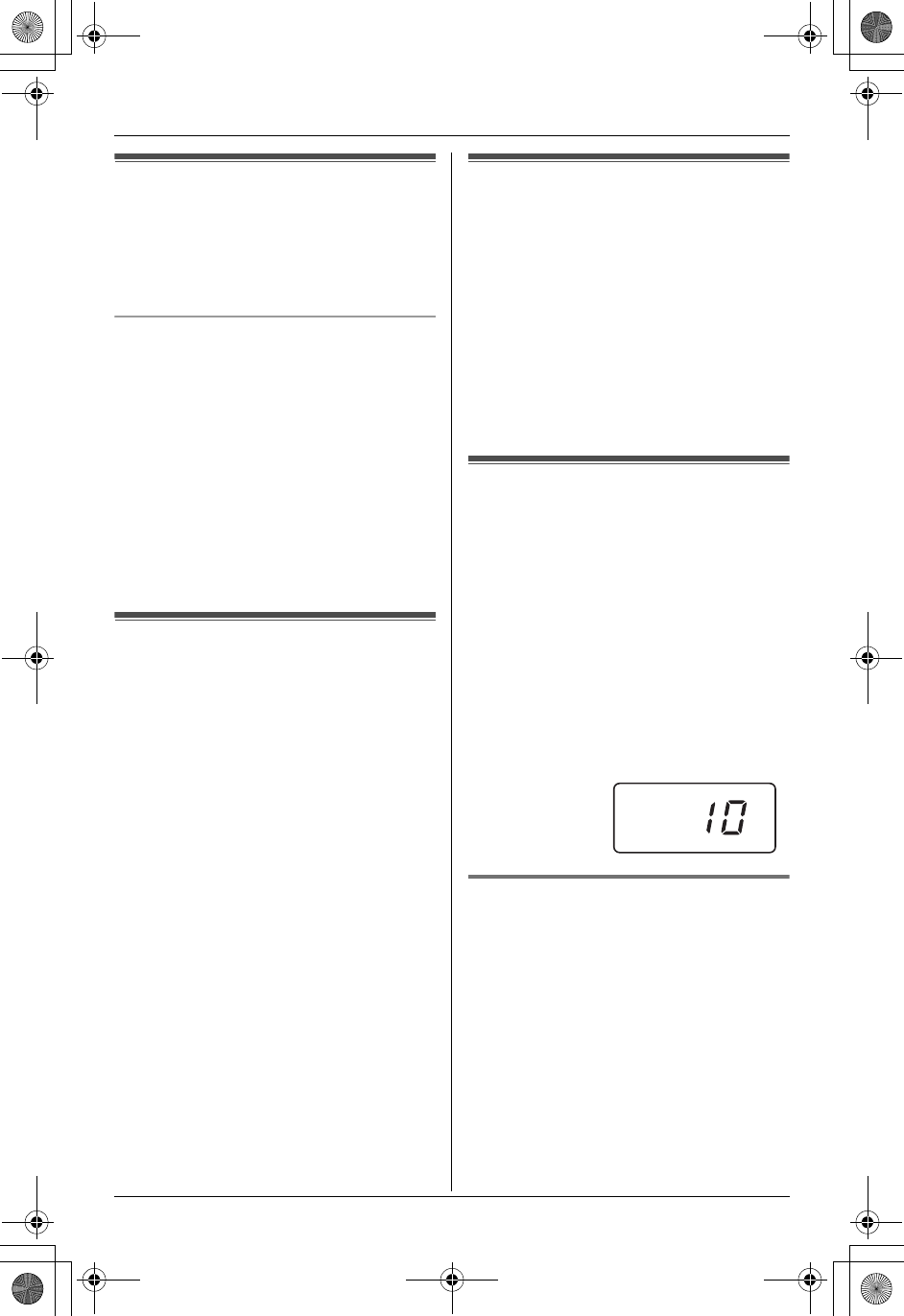
10
Using Caller ID service
This unit is Caller ID compatible. To use
Caller ID features, you must subscribe to
your telephone company’s Caller ID
service.
Caller ID features
When an outside call is being received, the
calling party’s name or telephone number
will be displayed.
Caller information for the last 50 different
callers will be logged in the caller list,
allowing you to return missed calls. Caller
information is stored by the most recent
call to the oldest.
LIf the unit is connected to a PBX system,
caller information may not be received
properly. Consult your PBX supplier.
Recording your greeting
message
You can record your own greeting
message (max. 2 minutes) that will be
played when the answering system
answers a call. If you do not record a
greeting message, a pre-recorded
greeting message will be used.
1Press {GREETING REC}.
LThe unit announces “To record
greeting, press record again.”
2Within 10 seconds, press {GREETING
REC} again.
3After the unit beeps, speak clearly
about 20 cm (8 inches) away from the
MIC.
LThe display will show the elapsed
recording time.
4To stop recording, press {GREETING
REC} or {STOP}.
Turning the answering
system on/off
Press {ANSWER ON}.
LWhen the answering system is turned
on, the ANSWER ON indicator lights
and the unit announces “Answer set”
and the day and time.
LWhen the answering system is turned
off, the ANSWER ON indicator turns off
and the unit announces “Answer off”.
Listening to messages
When new messages have been
recorded:
– The MESSAGE indicator on the base
unit will flash.
– The message indicator on the handset
will flash slowly if the message alert
feature is turned on.
The base unit display will show the number
of messages (old and new) recorded by
the answering system.
Example: The total number of recorded
messages is 10.
Listening to messages using
the base unit
Press {MESSAGE}.
LThe unit will announce the number of
new messages and will play back the
new messages.
LWhen you have no new messages, the
unit will announce “No new messages.
All message playback”, and will play
back all messages.
TG2431.book Page 10 Wednesday, September 22, 2004 1:17 PM
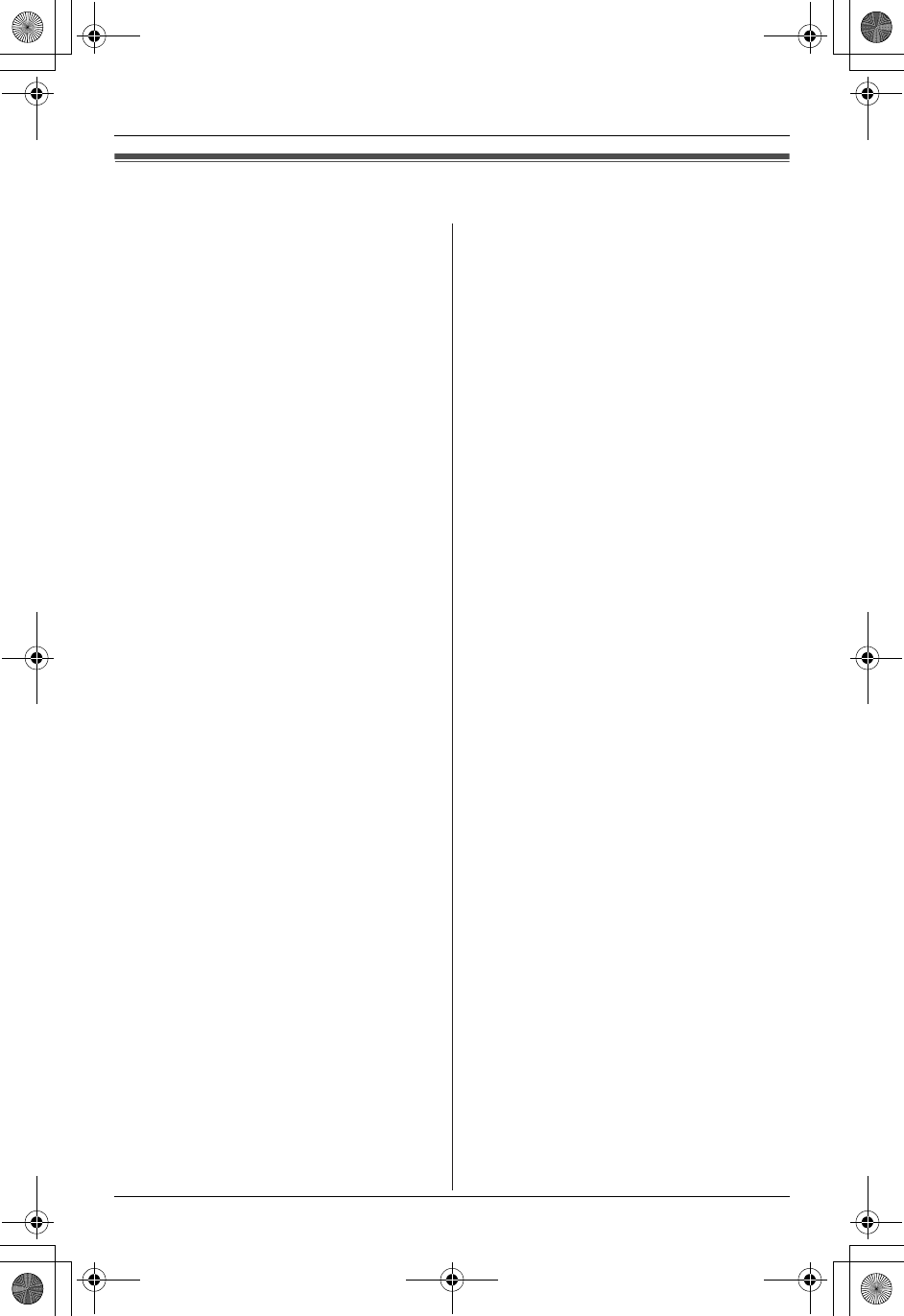
11
FCC and other information
This equipment complies with Part 68 of
the FCC rules and the requirements
adopted by the ACTA. On the bottom of
this equipment is a label that contains,
among other information, a product
identifier in the format US:ACJ----------.
If requested, this number must be
provided to the telephone company.
Registration No
............(found on the bottom of the unit)
Ringer Equivalence No. (REN).......0.1B
A plug and jack used to connect this
equipment to the premises wiring and
telephone network must comply with the
applicable FCC Part 68 rules and
requirements adopted by the ACTA. A
compliant telephone cord and modular
plug is provided with this product. It is
designed to be connected to a
compatible modular jack that is also
compliant.
The REN is used to determine the
number of devices that may be
connected to a telephone line. Excessive
RENs on a telephone line may result in
the devices not ringing in response to an
incoming call. In most but not all areas,
the sum of RENs should not exceed five
(5.0). To be certain of the number of
devices that may be connected to a line,
as determined by the total RENs, contact
the local telephone company. For
products approved after July 23, 2001,
the REN for this product is part of the
product identifier that has the format
US:AAAEQ##TXXXX. The digits
represented by ## are the REN without a
decimal point (e.g.,03 is a REN of 0.3).
If this equipment causes harm to the
telephone network, the telephone
company will notify you in advance that
temporary discontinuance of service may
be required. But if advance notice isn’t
practical, the telephone company will
notify the customer as soon as possible.
Also, you will be advised of your right to
file a complaint with the FCC if you
believe it is necessary.
The telephone company may make
changes in its facilities, equipment,
operations or procedures that could
affect the operation of the equipment. If
this happens the telephone company will
provide advance notice in order for you
to make necessary modifications to
maintain uninterrupted service.
If trouble is experienced with this
equipment, for repair or warranty
information, please contact a Factory
Servicenter or other Authorized Servicer.
If the equipment is causing harm to the
telephone network, the telephone
company may request that you
disconnect the equipment until the
problem is resolved.
Connection to party line service is
subject to state tariffs. Contact the state
public utility commission, public service
commission or corporation commission
for information.
If your home has specially wired alarm
equipment connected to the telephone
line, ensure the installation of this
equipment does not disable your alarm
equipment. If you have questions about
what will disable alarm equipment,
consult your telephone company or a
qualified installer.
This equipment is hearing aid compatible
as defined by the FCC in 47 CFR
Section 68.316.
TG2431.book Page 11 Wednesday, September 22, 2004 1:17 PM

12
When you hold the phone to your ear,
noise might be heard in your Hearing Aid.
Some Hearing Aids are not adequately
shielded from external RF (radio
frequency) energy. If noise occurs, use
an optional headset accessory or the
speakerphone option (if applicable) when
using this phone. Consult with your
audiologist or Hearing Aid manufacturer
about the availability of Hearing Aids
which provide adequate shielding to RF
energy commonly emitted by digital
devices.
WHEN PROGRAMMING EMERGENCY
NUMBERS AND(OR) MAKING TEST
CALLS TO EMERGENCY NUMBERS:
1) Remain on the line and briefly explain
to the dispatcher the reason for the
call.
2) Perform such activities in the off-peak
hours, such as early morning or late
evenings.
The software contained in this equipment
to allow user access to the network must
be upgraded to recognize newly
established network area codes and
exchange codes as they are placed into
service. Failure to upgrade the premises
systems or peripheral equipment to
recognize the new codes as they are
established will restrict the customer and
the customer’s employees from gaining
access to the network and to these
codes.
This device complies with Part 15 of the
FCC Rules. Operation is subject to the
following two conditions:
(1) This device may not cause harmful
interference, and (2) this device must
accept any interference received,
including interference that may cause
undesired operation.
Privacy of communications may not be
ensured when using this phone.
CAUTION:
Any changes or modifications not
expressly approved by the party
responsible for compliance could void
the user s authority to operate this
device.
NOTE:
This equipment has been tested and
found to comply with the limits for a
Class B digital device, pursuant to Part
15 of the FCC Rules. These limits are
designed to provide reasonable
protection against harmful interference in
a residential installation. This equipment
generates, uses, and can radiate radio
frequency energy and, if not installed and
used in accordance with the instructions,
may cause harmful interference to radio
communications. However, there is no
guarantee that interference will not occur
in a particular installation. If this
equipment does cause harmful
interference to radio or television
reception, which can be determined by
turning the equipment off and on, the
user is encouraged to try to correct the
interference by one or more of the
following measures:
− Reorient or relocate the receiving
antenna.
− Increase the separation between the
equipment and receiver.
− Connect the equipment into an outlet
on a circuit different from that to which
the receiver is connected.
− Consult the dealer or an experienced
radio/TV technician for help.
Some cordless telephones operate at
frequencies that may cause interference
to nearby TVs and VCRs. To minimize or
prevent such interference, the base of
the cordless telephone should not be
placed near or on top of a TV or VCR. If
interference is experienced, move the
cordless telephone further away from the
TV or VCR. This will often reduce, or
eliminate, interference.
TG2431.book Page 12 Wednesday, September 22, 2004 1:17 PM
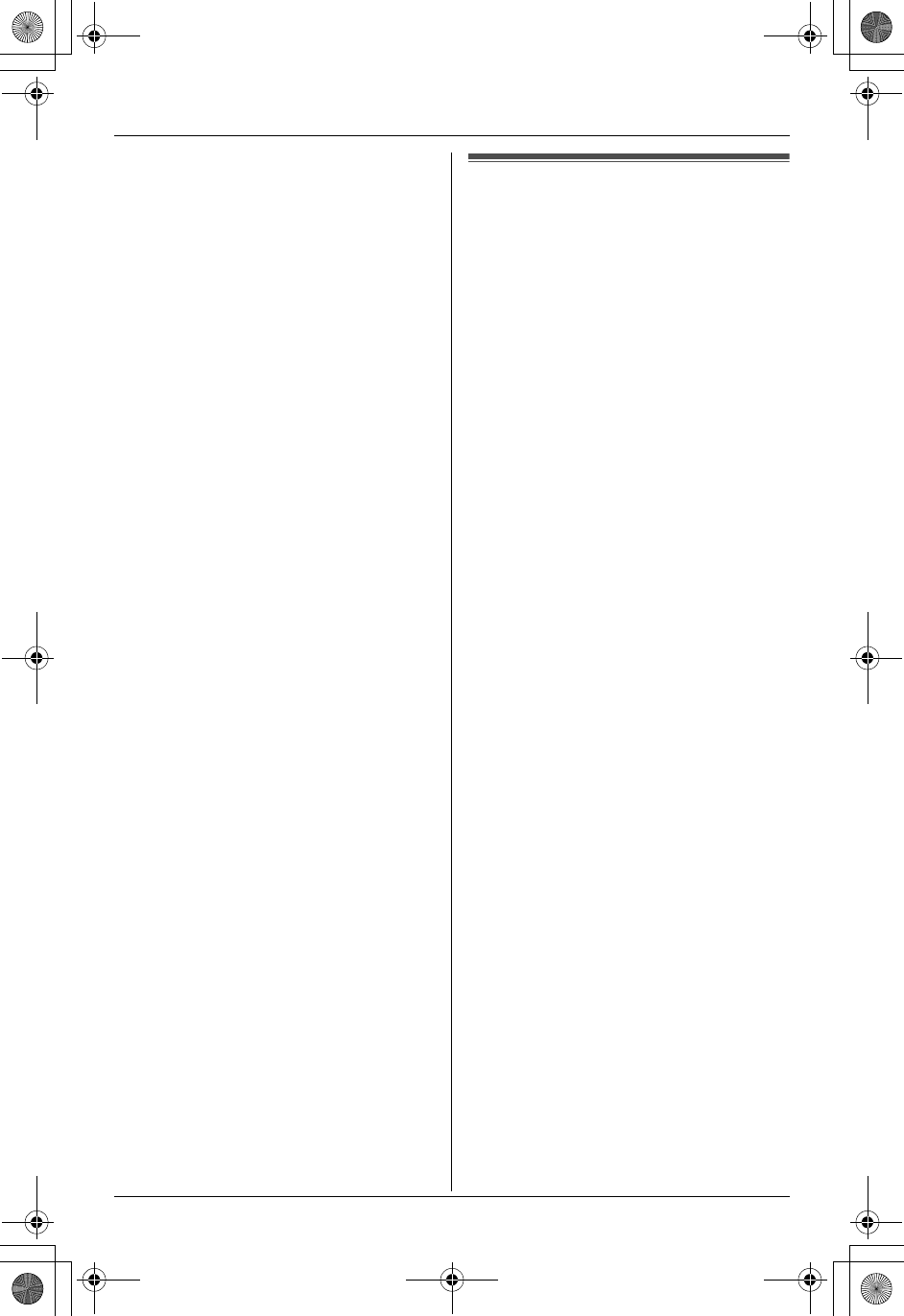
13
openLCR service for the
Caller IQ feature
This unit is compatible with service
provided by openLCR.
Important:
See the leaflet included with this unit for
more information.
LIf you have any questions regarding
the openLCR service, visit
www.openLCR.com or call openLCR
at 1-866-openLCR (1-866-6736527).
LNEITHER PANASONIC
COMMUNICATIONS CO., LTD. NOR
MATSUSHITA ELECTRIC
CORPORATION OF AMERICA IS IN
ANY WAY AFFILIATED WITH, OR
RESPONSIBLE FOR THE ACTS OR
OMISSIONS OF, OPENLCR.COM, INC.
NEITHER PANASONIC
COMMUNICATIONS CO., LTD. NOR
MATSUSHITA ELECTRIC
CORPORATION OF AMERICA NOR
ANY OF THEIR EMPLOYEES OR
AFFILIATES OR CUSTOMERS MAKE
ANY WARRANTIES OR
REPRESENTATIONS, EITHER
EXPRESS OR IMPLIED, TO ANY
CUSTOMER OR ANY OTHER THIRD
PARTY WITH RESPECT TO ANY OF
THE SERVICES PROVIDED BY
OPENLCR.COM, INC., NOR ASSUME
NOR CREATE ANY OTHER
OBLIGATION OF ANY KIND ON
BEHALF OF OPENLCR.COM, INC.
LThe Caller IQ service can only be
activated after registering with openLCR
at www.openLCR.com. More
information regarding the openLCR
service is available on the Internet at
www.openLCR.com.
FCC RF Exposure Warning:
This product complies with FCC radiation
exposure limits set forth for an
uncontrolled environment. To comply
with FCC RF exposure requirements the
base unit must be installed and operated
with its antenna located 20 cm or more
between antenna and all person’s body
(excluding extremities of hands, wrist
and feet). The handset unit may be
carried and operated with only the
specific provided belt-clip. Other non-
tested belt-clips or similar body-worn
accessories may not comply and must
be avoided. The base and handset units
must not be co-located or operated in
conjunction with any other antenna or
transmitter.
TG2431.book Page 13 Wednesday, September 22, 2004 1:17 PM
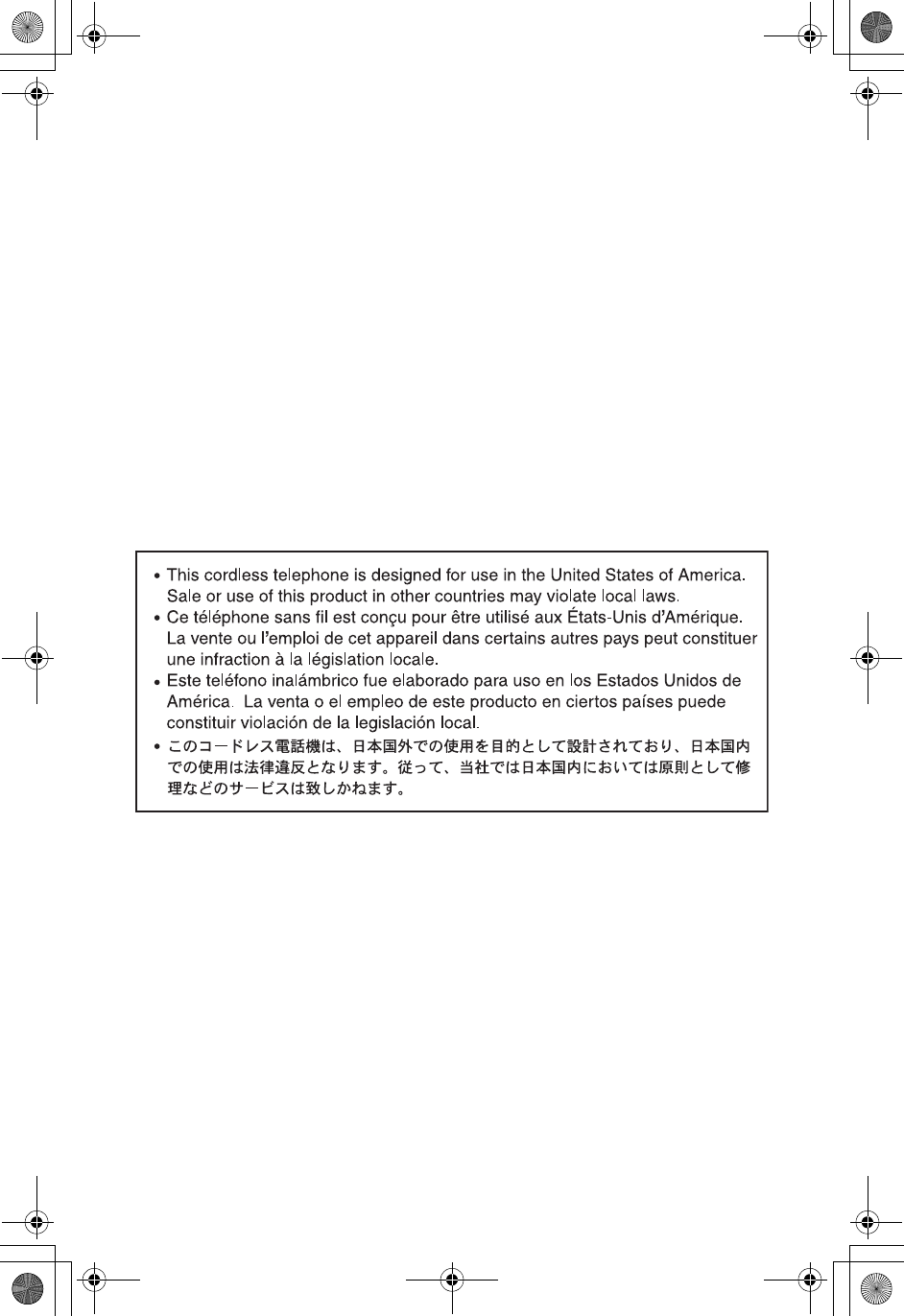
If you need assistance with setup or operation;
1Visit our website: http://www.panasonic.com/support
2Contact us via the web at: http://www.panasonic.com/contactinfo
3Call us at: 1-800-211-PANA (7262)
TTY users (hearing or speech impaired users) can call 1-877-833-8855.
When you ship the product;
LCarefully pack your unit, preferably in the original carton.
LAttach a letter, detailing the symptom, to the outside of the carton.
LSend the unit to Panasonic Services Company Customer Servicenter, prepaid and
adequately insured.
LDo not send your unit to Panasonic Consumer Electronics Company listed below or to
executive or regional sales offices. These locations do not repair consumer products.
Panasonic Consumer Electronics Company,
Division of Matsushita Electric Corporation of America
One Panasonic Way, Secaucus, New Jersey 07094
Panasonic Sales Company,
Division of Matsushita Electric of Puerto Rico, Inc.
Ave. 65 de Infantería, Km. 9.5, San Gabriel Industrial Park
Carolina, Puerto Rico 00985
TG2431.book Page 14 Wednesday, September 22, 2004 1:17 PM